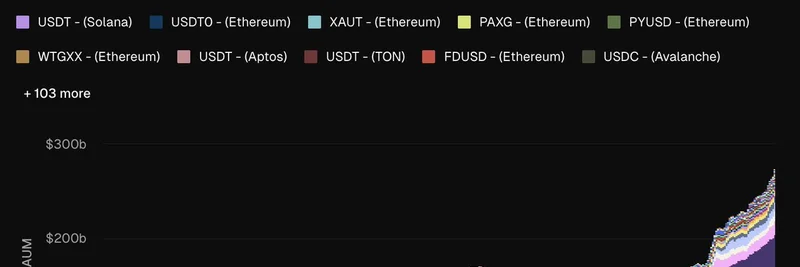Hey crypto fans, have you heard the latest buzz in the blockchain world? Tokenized assets are smashing records, and it's all thanks to a recent update from Token Terminal. The assets under management (AUM) for these digital wonders has skyrocketed to an all-time high of about $270 billion. That's not just a number—it's a sign of how far crypto has come in bridging the gap between traditional finance and the decentralized future.
For those new to the term, tokenized assets are basically real-world assets like currencies, commodities, treasuries, private credit, private equity, and venture capital that get represented as tokens on a blockchain. This tokenization process makes them more accessible, liquid, and efficient to trade, often with lower fees and faster settlements.
Breaking Down the Growth in Tokenized Assets
Token Terminal dropped this bombshell in a post on X, highlighting the explosive growth trajectory. Their chart paints a clear picture: starting from humble beginnings around 2018, the AUM has climbed steadily, with a sharp uptick in recent years. By mid-2025, we're looking at a stacked landscape where multiple assets contribute to this massive total.
As you can see, the chart breaks down the top contributors, with over 103 assets in the mix. This diversity shows how tokenization is expanding beyond just stablecoins to include a wider array of financial instruments.
USDT on Tron: The King of Tokenized Assets
In a follow-up to their announcement, Token Terminal pointed out the biggest player in this space: Tether's USDT on the Tron blockchain. Tron, known for its high throughput and low transaction costs, has become a hotspot for stablecoin activity. USDT on Tron alone accounts for a significant chunk of that $270 billion, making it the largest tokenized asset by AUM.
Why Tron? It's simple—efficiency. Tron's network handles massive volumes without the gas fees that plague other chains like Ethereum. This has made it a favorite for everyday transactions, remittances, and even DeFi applications where stablecoins are key.
One community member noted that Tron hosts over $83 billion in USDT, emphasizing its dominance but also raising flags about centralization risks. After all, while blockchain promises decentralization, stablecoins like USDT rely on issuers' reserves, which aren't always transparent.
How This Ties into Meme Tokens and Blockchain Innovation
At Meme Insider, we're all about meme tokens, so let's connect the dots. Stablecoins like USDT provide the essential liquidity backbone for trading meme coins on decentralized exchanges (DEXs). With tokenized assets hitting these highs, it means more capital is flowing into the ecosystem, potentially boosting volatility and opportunities in the meme space.
Think about it: higher AUM in stablecoins often translates to more trading pairs, better price stability during pumps, and easier on-ramps for new users diving into meme coin mania. Plus, as tokenization tech evolves, we might see meme projects experimenting with real-world asset integrations, like tokenized memes tied to NFTs or community funds.
Other reactions from the community include optimism about Solana catching up, hinting at a competitive landscape where multiple chains vie for tokenized asset dominance.
What's Next for Tokenized Assets?
This milestone isn't just a pat on the back for crypto—it's a harbinger of mainstream adoption. As regulations catch up and more institutions tokenize their assets, we could see trillions in AUM down the line. For blockchain practitioners, this is a cue to level up your knowledge on platforms like Tron and Ethereum, where much of this action is happening.
If you're keen to dive deeper, check out the original thread on X for the full scoop. And stick around Meme Insider for more insights on how these trends impact your favorite meme tokens.
What do you think—will USDT on Tron keep its crown, or will another chain steal the spotlight? Drop your thoughts in the comments!



